Dubrovnik: Walls and Water
21 April, 2008, 00:33 am in "Croatia"
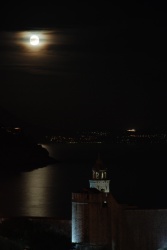 Grey woolly clouds hid the sky over the hills and ocean, as we left Split. The bus ride followed the coast, which was mostly large expanses of emerald trees ripped by white rock. The sea, in spite of the gray sky, managed to keep its jewel-like color, only slightly muted. Below the patches where the sky managed to find a hole in the clouds, the sea would flash turquoise and the land would seem to glow like a brief smile.
Grey woolly clouds hid the sky over the hills and ocean, as we left Split. The bus ride followed the coast, which was mostly large expanses of emerald trees ripped by white rock. The sea, in spite of the gray sky, managed to keep its jewel-like color, only slightly muted. Below the patches where the sky managed to find a hole in the clouds, the sea would flash turquoise and the land would seem to glow like a brief smile. At the bus station, still out of view of the legendary old town, we were surrounded by people offering rooms. I selected one who said she had an apartment with a private bath and shared kitchen (shared with other boarders), 15 minutes walk from the old town.
"She lies!" another woman shouted. "It's far!" "50 minutes is more like it!" a man added. I just wanted to get away from all the people pushing cards and photos of their rooms at me. Rowshan wanted to look at other options. Eventually he joined our host and I but had to remove a woman who was clinging to him.
The room was nice, newly made and clean but it took us about 20 minutes to walk to the old town and longer to get back since the apartment was up a hill. We decided it was fine.
Our first walk into town worried us since we couldn't see the town until we were there due to the way the street ran and the houses around the stairways we walked down. When we saw it, it looked formidable with strong curving walls and large buildings.
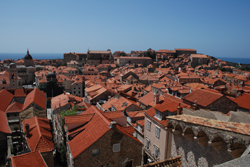
Where Split is built into ruins of the ages, from Roman through Medieval, Dubrovnik is a fortified, Renaissance town. The buildings boast several stories and the town looks well maintained and restored. We entered through a gate with a niche where a statue of the guardian of the city stood.
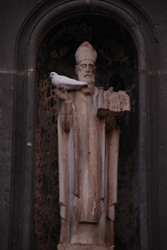
The restoration, it turns out was all done in the last 10 years, since the old town was severely damaged during the Yugoslavian war in the 90s. A large sign at one of the entrances showed all the parts that were damaged, some by direct hits, others by fire or shrapnel. A sticker had been stuck at the top of the sign read "Ubit Srbia", "Kill Serbia" showing all is not forgiven.
The old town is car free and its streets are full of tourists. The main street is spacious with narrower streets leading in straight lines off of it. Several apartment lined stairways led steeply up from the center of town to the outer walls, many gracefully lined with potted plants.
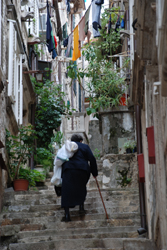
Through the Northern gate, there is a water tower where women sell crafts as well as some interesting stone carvings on the buildings surrounding it.
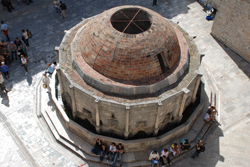
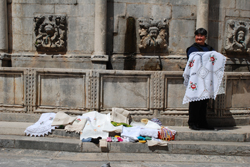
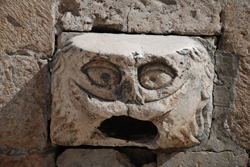
At dusk we walked up the hill next to the old town, looking for a good view of the town. The weather covered the town in a gauzy haze. It looked silent. As we walked, the evening lights were gradually turned on, green around the outer walls, white and gold inside, turning the gray stones silver. The town looked like a piece of jewelry resting on a dark blue velvet ocean. A silken breeze brushed against us as we watched the city.
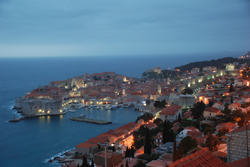
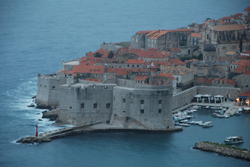
Dubrovnik Walls
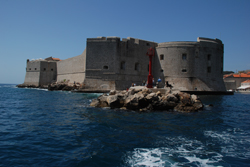
The old city of Dubrovnik is surrounded by almost 2 km of heavy stone walls which in some places reach a height of 25 meters. The strong but graceful walls also contain a couple fortress towers as well as many watch towers. From the walls, one has a perfect view of the inner town, whose tile roofs and stone walls resemble a mosaic below, as well as stunning vistas of the sea and the hills above the town.
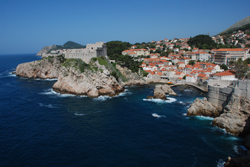
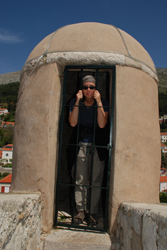
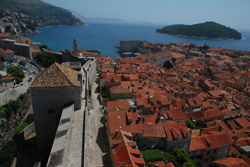
The buildings of the town seem safe and secure, nestled inside the towering walls, but with modern weapons, the Serbian and Montenegrin armies were probably able to sit far above in the hills and easily fire upon the town. From that point of view, the town looked like a wounded seabird, unable to fly into the hills and unable to swim away into the
sea.
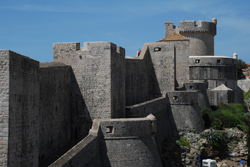
It was a perfect day for walking the walls.
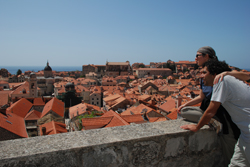
The sky was cloudless and the smell of orange blossoms overpowered the smell of the sea. One of the first sites we could see was the Fort Lourijenac, outside the walls, perched on towering rocks which were dusted with spring plants. The deep turquoise blue sea gnashed at the base with white foam teeth which stood out against the otherwise calm sea.
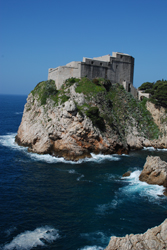
We continued on, looking down at peoples' yards and gardens full of orange, lemon and lilac trees, as well as lush green vegetables and orange poppies. Laundry was strung on lines stretching from buildings to the walls.
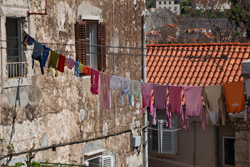
Some people had built grape arbors where grape vines had begun to twine. Occasionally we'd see one of the many Dubrovnik cats sunning themselves on white stone or crouching in the grass or flowers.
The walk progressed upward until we stood high on the walls closest to the sea, which were perched up on steep cliffs. Then the walls curved around so we could view the island of Lokrum and the harbor. Church towers, domes, and bell towers rose from the city. Though there were already lots of people roaming the streets, the city seemed silent except for soft church bells and birds singing.
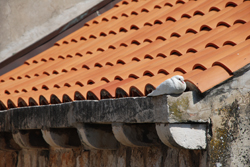
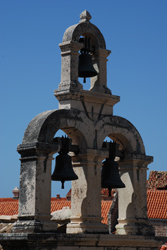
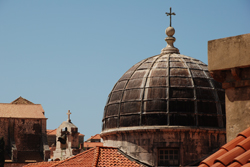
Eventually we reached the back stretch with views of the steep apartment and plant lined streets into the city. At various points of the walls, we'd seen ruined buildings, sometimes transformed into gardens.
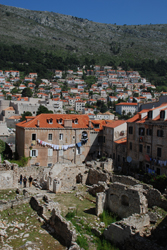
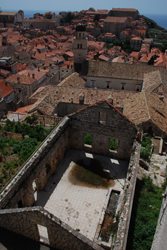
After the walls, we caught a boat to Lokrum, wanting to take full advantage of the weather. Lokrum is about a 20 minute boat ride away. The island is completely covered with trees, except for the edges which are made up of white-gray rocks lined and cracked like elephant skin.
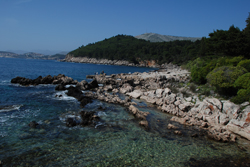
We were soon walking completely alone through the forest and along the beach. People aren't allowed to stay over night on the island, however, there is a huge population of semi-feral peacocks who occupy the place. People leave piles of crumbs for them. One woman who must have been a regular had a whole flock start running after her when they caught site of her. She produced bags of crumbs and some other peacock treats.
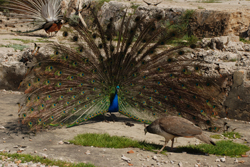
Following some peacocks, we found ourselves overlooking a protected cove filled by water from the ocean through a cave. We waded a little but found the water icy. A peacock scolded us loudly, his neck was about the same color as the water.
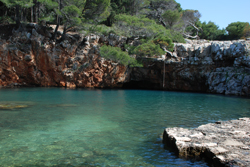
Leaving the "Dead Sea", as it was called, we visited the ruins of a 12th century Benedictine Monastery, then climbed to the top of the island for a view from Fort Royal, which was built by the French Occupation in the early 1800s.
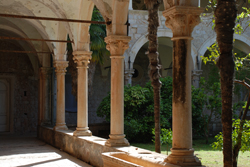
Time had managed to slip by quickly on this slow peaceful island and we soon had to scurry down the path to catch the last boat to town.
In the evening Rowshan went out to take night pictures of the town.
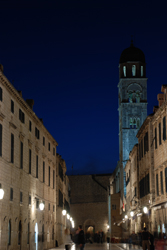
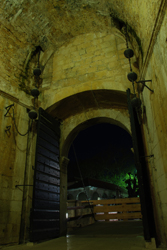
Our last day in Dubrovnik was overcast so we hiked up a couple staircases into the hills, then up a rougher stairway which led to a path through rocky parkland to Bosanka, a village above Dubrovnik. There we saw some feral goats.
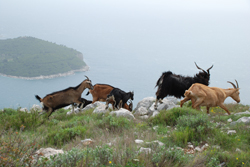
Here we began to see more blatant war damage lacking in the restored lower town: ruins of buildings as well as graves with dates like b. 1970 d. 1993. A painful reminder that the soldiers killed were roughly the same age as I was.
The top of the hill had a huge white cross with an alter but no names or explanation. Beyond that were the twisted ruins of a chairlift and another ruined building.
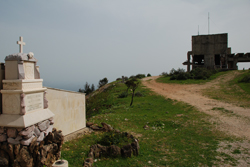
Both had burnt out holes where they'd been hit during the war. Nature had attempted to cover these wounds of war with plant life. A little farther off was another grave of 3 soldiers. A strong wind gave the shredded metal chairlift mechanism a voice and it creaked and sighed.
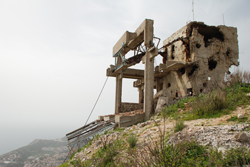
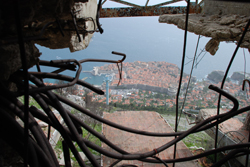
We descended into town and walked some more, noticing a church with a bullet scar and another semi-ruined building.
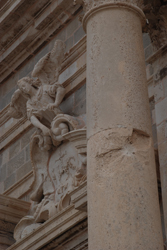
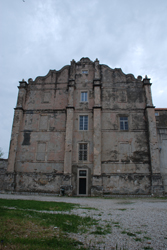
In the evening, the sky turned rose casting the ocean into a lavender haze.
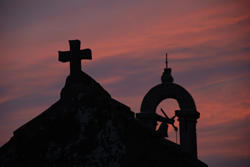
Comments
- Comments
Powered by My Blog 1.69. Copyright 2003-2006 FuzzyMonkey.net.
Created by the scripting wizards at FuzzyMonkey.net..
(Code modified by Rowshan Dowlatabadi)
Created by the scripting wizards at FuzzyMonkey.net..
(Code modified by Rowshan Dowlatabadi)

